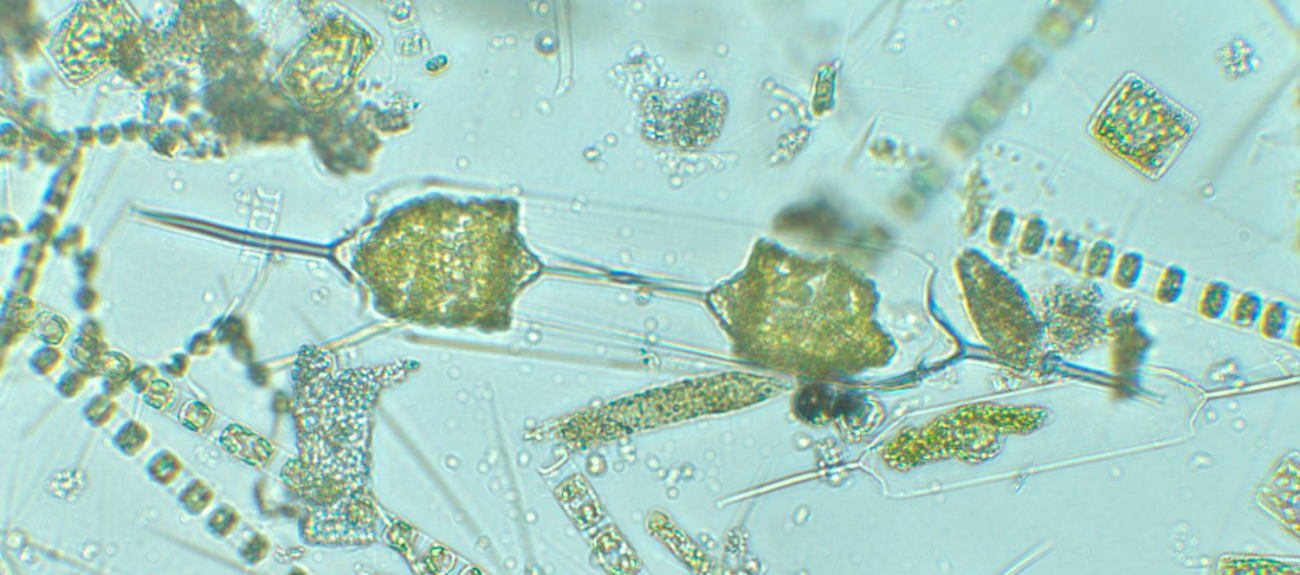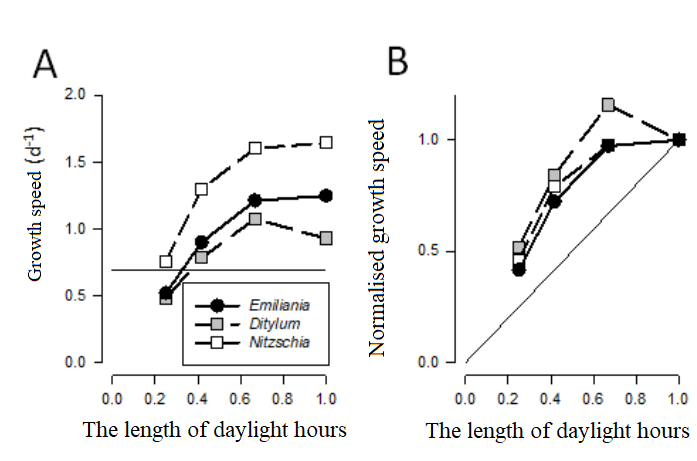
Source: https://www.earthobservatory.nasa.gov/images/145151/beauty-and-a-burden-in-the-norwegian-sea
Planktonic unicellular algae account for 50% of global carbon fixation. However, these microorganisms face a problem: for about half of their vegetative life, at night, they are unable to fix carbon and actively synthesize proteins, which is necessary for the G1 phase (the first of three phases) of the cell cycle. Empirical data indicate that the average daily growth of microalgae depends on their ability to quickly synthesize organic matter, but they must also have a sufficient number of metabolites in the cell. The figure shows examples of experimental dependences of the growth rates of different phytoplankton species on the duration of daylight: it is clear that this dependence is nonlinear. A fundamental question arises about the optimal physiological configuration of phototrophic organisms to maintain such activity under a daily light-dark cycle.

Source: https://en.wikipedia.org/wiki/Ditylum_brightwellii
In a joint study by scientists from the Severtsov Institute of Ecology and Evolution of the Russian Academy of Sciences (IEE RAS) (Russia) and the Plymouth Marine Laboratory (United Kingdom), computer modeling was used to study the optimization of carbon fixation by unicellular phototrophs. The proposed methodology is based on the quota concept, in which the internal limiting resource is carbon itself, proportional to the total carbon biomass of the organism. The proposed simplified mathematical model of the cell consists of only two compartments: the metabolite compartment and the compartment for the synthesis of organic carbon compounds. The metabolite compartment provides the synthesis of hydrocarbon compounds, but it does not require additional carbon consumption.
"Despite the relative simplicity of the proposed model, it is capable of reproducing the general picture of growth at different day lengths and demonstrates a decrease in C-fixation in the afternoon. Particular emphasis in the study was placed on testing the effectiveness of the physiological configuration of cells, leading to the optimality of their functioning," said Andrey Morozov, senior researcher at the IEE RAS.
The work shows that although the rate of C-fixation (i.e. the rate of conversion of inorganic carbon to organic matter) required to maintain a given growth potential generally increases linearly with the inverse ratio of daylength to photoperiod, the relationship with the maximum metabolite compartment size relative to whole organism biomass is determined by the ratio of daylength to organism doubling time. Thus, faster growing organisms require not only a higher rate of resource assimilation for a given combination of daylength and maximum growth rate, but also a higher metabolite compartment mass.

The results obtained may be crucial for understanding the patterns of geographical distribution of planktonic phototrophs at different latitudes during the seasons and may affect the competitive advantage of organisms that will grow under climate change scenarios. In particular, the model predicts that larger vacuolated organisms (e.g. diatoms) that have a larger metabolite compartment may have an advantage in such situations. On the other hand, the requirement for a high mass of the metabolite compartment limits the competitiveness of fast-growing microorganisms to lower latitudes and/or longer daylight hours.
The results are published in PLOS Computational Biology. Flynn, K.J. and Morozov, A.Y., 2025. Resource acquisition in diel cycles and the cost of growing quickly.// PLOS Computational Biology, 21(6), p.e1013132, doi.org/10.1371/journal.pcbi.1013132
